#A Chinese Odyssey: Part Three
Explore tagged Tumblr posts
Text
A Chinese Odyssey Part Three (2016) 大话西游3















Director: Liu Zhenwei Screenwriter: Liu Zhenwei Starring: Han Geng / Tang Yan / Wu Jing / Karen Mok / Zhang Chao / Zhang Yao / Wang Yibo / Gillian Chung / Xie Nan / He Jiong / Hu Jing / Huang Zheng / Stephen Chow / Cao Seung-yeon / Zhou Yixuan / Yuan Kui / Lü Jianmin / Wang Feifei / Du Juan / Wang Xingang / Chai Ge / Zhou Jin / Zheng Wenzheng / Ye Liu / Liu Jing / Peng Xintong / Xi Wei / Yu Guanghong Genre: Comedy / Romance / Fantasy Production Country/Region: Mainland China / Hong Kong China Language: Mandarin Chinese Date: 2016-09-14 (Mainland China) Duration: 93 minutes Also known as: The End of the Westward Journey / A Chinese Odyssey: Part Three / A Chinese Odyssey Part III / 大话西游终结篇 IMDB: TT4862468 Type: Reimagining
Summary:
Taking place in an alternate timeline, Fairy Zixia used the Pandora's Box to travel forward in time to see the consequences of leaving a tear drop in Joker's heart, which led to her "demise" and Joker being revealed as the reincarnation of the Monkey King. Fearing for her life and Joker's mental well being, she denounced her relationship to Joker, which led to him asking about what happened in the future. Zixia revealed to him the fact that she left a mark in Joker's heart, leading to Bai Jing Jing realizing that Joker will eventually stop having feelings for her, leading him to fall for Zixia.
However, Zixia withheld the information about Joker being the Monkey King's reincarnation and tried to make things right by forcing Joker into meeting with Bai Jing Jing much earlier than in the original timeline. Unfortunately, Joker had already stopped having feelings for Jing-Jing and prevented Zixia's plan from going any further resulting in a slap from Zixia. After having a talk with Qingxia (Zixia's twin sister trapped in her body), Zixia decided to go the Bull Demon King and marry him so Joker can stop falling for her so she left Joker - who was looking for her after being slapped - alone by himself.
Joker continues his search for Zixia in the desert, where he witnessed this timeline's version of the Monkey King being subdued by Guanyin, with the difference being that the Longevity Monk used the Pandora's Box to escape from being killed by the Monkey King and the time to subdue the Monkey King took longer than expected. After Guanyin left with the subdued Monkey King, Joker found himself left with the returning Longevity Monk and both were caught together by the Bull Demon King, being happy about having a second wife and the Longevity Monk being captured.
Meanwhile, in Heaven, Guanyin handed over the subdued Monkey King to the Jade Emperor, discussing about the overwhelming presence of demons and fearing that the Sealed Book had a mistake in it, which Jade Emperor reassures her that the Book is never wrong. As Guanyin left to report the progress to the Buddha, the Jade Emperor unsealed the Monkey King, who is revealed to be the Six-Eared Monkey, revealing that the Sealed Book did not mention about the Monkey King in the initial pilgrimage at all as he was born 500 years later as Joker, causing the Jade Emperor to get the Six-Eared Monkey fill in the role until Joker arrived from the future. This eventually leads to the Jade Emperor betraying the Six-Eared Monkey and have him slowly burn in the Great Oven.
In the residence of the Bull Demon King, Zixia and Qingxia were talking about the possible married life with the Bull Demon King, with Zixia realizing that the Pandora's Box was missing and suspecting that Qingxia had given it to the Six-Eared Monkey, with a flashback revealing that she was an ex-lover of his. Zixia was soon confronted with Princess Iron Fan (铁扇公主) and her son Red Child (红孩子), resulting in a fight between the two women, leading Zixia being blown past the just arrived Bull Demon King, Joker and Longevity Monk. The Bull Demon King, realizes the trouble he's in and instructs Joker to take the Longevity Monk and Zixia to his sister, Xiang Xiang while he tries to stall the Princess for time. While on the run, Joker demands to know why Zixia left him alone whereas the Longevity Monk accidentally found a way to leave by freeing one of the Bull King's Giant Bulls. The trio escaped, but were chased by Red Child until both Joker and Logevity Monk accidentally stole his fire wheels (used for flight).
Upon arriving at Xiang Xiang's Palace, the trio met with Xiang Xiang and, much to their horror, witnessed her devouring a man whole. She challenged the trio and defeated them, leading them to being locked up in the dungeon. It was then that Zixia tells Joker about her demise in the original timeline, and why she tried so hard to stop Joker from developing feelings for her. At the same time, the Bull Demon King arrived to reconcile with Xiang Xiang about the execution of her lover, Mantis, by his own hands, which she rejected as Mantis was the only true love to her. It was at this time that the Longevity Monk played the main theme of the entire A Chinese Odyssey series, leading to Joker and Zixia kissing at the end of the song. The Demon Bull King and Xiang Xiang saw the silhouettes of them kissing, causing the siblings to burst into the dungeon only to see the Longevity Monk taking Zixia's place. When Xiang Xiang saw this, she ended up drooling implying that she's interested in Joker, thus allowing the Bull Demon King giving his blessing to Joker for Xiang Xiang's hand in marriage.
While preparations for the Bull Demon King's 2nd wedding is underway, Joker and Xiang Xiang talked about Mantis and the reason she did not use the Pandora's Box to prevent his death while the Bull Demon King tried to impress Zixia. He asked Joker for tips on how to impress Zixia, with Joker using the Pandora's Box multiple times, the first few times to play a game on the Bull King, 2 times to get rid of the Bull King and Xiang Xiang, and the last to get himself and Zixia away from the ceremony, only for the plan to backfire forcing all 4 of them to return. The Bull Demon King, angry at the series of events, tries to kill Joker while Xiang Xiang chases after Zixia, only to have Zixia captured while Qingxia was forced out of Zixia's body. The Bull Demon King's rampaging was soon interrupted by the arrival of his wife, Princess Iron Fan and Red Child, only for him and Red Kid to find out the Princess had an affair with the Monkey King, causing him to punish Joker and Zixia by forcing them to marry at the ceremony.
Meanwhile, in Heaven, the Jade Emperor was shocked to find out the Sealed Book had changed, forcing him to free Six-Ear Monkey from the Great Oven, and accidentally revealing to him that the Longevity Monk is the Monkey and Qingxia's son and finding out that Qingxia knew everything about the mistake in the Sealed Book. Thus, the Jade Emperor allowed Qingxia to repossess her body and let Six-Eared Monkey to go rescue his son while still under the guise of the Monkey King. Six-Eared Monkey crashed the wedding, revealed that he started the affair with the Princess, while maintaining "the fact" that Joker is not the Monkey King, and started battling with the entire Bull household, with Qingxia arriving later rescue Zixia from Xiang Xiang and trading places with Zixia in order for the prophecy to remain true, with a few changes. The battle ended up with the Bull siblings finally reconciled as Xiang Xiang being forced to consume her brother just so to have a fighting chance against Six-Eared Monkey. The Heavenly Army arrived to provide backup for Six-Eared Monkey, Qingxia sustaining a blow in the process. As he saw this, Six-Eared Monkey breaks free from Xiang Xiang's grasp to grab Qingxia while the Heavenly Army and General Li Jing dealt the final blow and sealed Xiang Xiang once and for all.
Five hundred years later, Six-Eared Monkey accompanied his son and his disciples on the pilgrimage, while Joker and Zixia watch on after kissing on the top of the wall, mentioning about Six-Eared wanting to be reunited with Qingxia as quickly as possible. One day in Heaven later (10 years later on Earth), Longevity Monk became a Buddha while his parents stay together as the Wick for the Buddha's Lamp, only for their day interrupted by the Jade Emperor saying that the Sealed Book changed again.
Source: https://en.wikipedia.org/wiki/A_Chinese_Odyssey_Part_Three
Link: N/A
#A Chinese Odyssey Part Three#大话西游3#The End of the Westward Journey#A Chinese Odyssey: Part Three#A Chinese Odyssey Part III#大话西游终结篇#jttw media#jttw movie#movie#live action#reimaging#reimagining#replay#The Monkey King#Six-eared Monkey#Zixia / Qingxia#Tang Seng#Bull Demon King#Niu Xiangxiang#Princess Iron Fan#White Bone Demon#Bai Jingjing#Black Spider Demon#Guanyin#Goddess of Mercy#Red Boy#Erlang Shen#Yang Jian#Jade Emperor#Subhuti
8 notes
·
View notes
Text
10 books to read in 2025
(tagged by @hunxi-after-hours)
Let's ignore the fact that it's already 1/3 of the way through the year, shall we?
I'm narrowing this down by keeping it to non-webnovel fiction only (I keep separate lists for webnovels and nonfiction, both of which are long enough on their own). I'm also excluding anything I've already started reading (which eliminates another uh... more than I'd like to admit). Anyway, that puts us in the part of my reading list that I vaguely structure by language, so:
The Iliad, trans. Emily Wilson - I found her translation of The Odyssey (and her commentary on it and the translation process) to be an interesting read, so I'm curious to see what she does with The Iliad. Also I just really like the story and will happily take the excuse to 'reread' it.
The Priory of the Orange Tree by Samantha Shannon - I heard such good things about it and then never got around to reading it.
Children of Time by Adrian Tchaikovsky - I went through this phase when I was younger where I thought I hated all scifi, and then I realised I just hated a lot of the 'classics' of the genre written in, like, 1950-1980, and that there's a lot of the genre I do actually quite enjoy. I have read a fair bit of it since, but I still have some catching-up to do.
House of Leaves by Mark Z. Danielewski - I just feel like I should have read this by now. My excuse was that I was waiting until I was in a place to acquire more physical books but really I've just been kind of scared of it.
《长安的荔枝》 (The Litchi Road) by 马伯庸 / Ma Boyong - I recently read another of his novels (《太白金星有点烦》 / The Annoyance of the Gods, about the overworked gods who coordinate the whole Journey to the West behind the scenes) and very much enjoyed it, so went looking for more. I like the premise of this one as another behind-the-scenes take on a well known story, and am looking forward to seeing where he goes with it.
《三国演义》 (Romance of the Three Kingdoms) attributed to 罗贯中 / Luo Guanzhong - I've read abridgments. I've read adaptations. I've read poems and commentaries and inspired-bys and let's not even start on dramas. But I have let the OG unabridged version gather dust on my shelves whilst I stare at it like a coward.
El Problema de los Tres Cuerpos (三体) by 刘慈欣 / Liu Cixin, trans. Javier Altayó Finestres - This is a project of sorts that I kind of stumbled into, where I'm trying to read this novel in every language in which I am literate. I first read it in the original Chinese and then went straight to Ken Liu's English translation (The Three-Body Problem) because I had heard such good things about the translation, and wanted to study it under a microscope. Then I happened across a translation into a different language with an interesting-looking foreword, and picked it up on a whim. And it spiralled from there. I wouldn't call this a favourite novel, yet here I am, reading it for the 5th (and last, unless I learn another language or decide to torture myself with Italian) time. But it's been interesting seeing how the translation differs between target languages, and I will definitely try something like this again with other novels.
Les fiancés de l'hiver (A Winter's Promise) by Christelle Dabos - I'm well-read in the French classics but woefully out of touch with more contemporary novels, and have read almost no original French speculative fiction at all, which felt like an oversight. So I asked for recommendations at a local multilingual bookstore and came away with this one.
La plaça del diamant (The Time of the Doves) by Mercè Rodoreda - for reasons of trying to get a good grade in immigrant.
Permagel (Permafrost) by Eva Baltasar - I was browsing the indie bookstore near me for language reasons and it was featured prominently on the queer lit recs shelf.
Tagging @redbelles, @kelsiers, @veliseraptor, @venndaai, @stripedroseandsketchpads, and anyone else who has a reading list you feel like sharing (if you think 'I want to do this but I wasn't tagged' please do it and say you were tagged by me so I can steal recommendations from your lists)
37 notes
·
View notes
Text
“10 People I’d Like to Know Better” Tagged by @rubeau-art
Last song: 'Pink Pony Club' - Chapell Roan
Favorite color: Blue
Last book: "In Deeper Waters" by FT Lukens
Last movie: Chinese Odyssey, Parts 1 and 2. It's a trip.
Last TV show: Batman the Animated series from the 1990s. That is still some great storytelling.
Sweet/Spicy/Savory: One of my favorite dishes is sweet and spicy chicken ramen so... all three?
Current obsession: Taking apart old political books so I can reuse the boards to bind fanfiction. It allows me to be destructive while also being constructive.
Last thing searched: Helpless, batman, ao3
Looking forward to: An outing with friends later this Feb!
4 notes
·
View notes
Note
I read your and some other Greek people's accounts on race within depictions of Deities, and I fully see where you're coming from! Can you please comment on instances of Deities of Greek Pantheon being depicted as Black-coded within Ancient sources though? Like, since "Zeus Athiops" is a thing, and we know that this word has skin color connotations + specific African region.
I hope this doesn't come off as a weird question. Like, I fully see where "depict Greek Deities as Greek or mixed with Greek" comes from! And yet I'm curious what we should do with cases where a Greek Deity is either moved to another ethnic region via usage of epithets... or when the Greek Deity is initially from a different region in the first place, like acquired cult?
If it helps, I'm not American and I know the whole race issue is an American thing. So, do you think that depictions of Greek Deities can look a variety of ways as long as there's something Greek about them? /gen
Thank you for your time!
I believe there's more to Zeus's "Athiops" to explore. By quote:
AE′THIOPS (Aithiops), the Glowing or the Black. A surname of Zeus, under which he was worshipped in the island of Chios. Ancient Aethiopia, (Greek: Αἰθιοπία, romanized: Aithiopía; also known as Ethiopia) first appears as a geographical term in classical documents in reference to the upper Nile region of Sudan, as well as certain areas south of the Sahara. Its earliest mention is in the works of Homer: twice in the Iliad,and three times in the Odyssey. The Greek historian Herodotus "specifically" uses the appellation to refer to such parts of sub-Saharan Africa as were then known within the inhabitable world.
But these were regions back then and places within the Greek expansion so the people of that region likely referred to him that way, but not to explicitly state the colour of his skin.
In previous posts i have mentioned that i would really prefer to have the Greek gods look like Greeks, since that's the place they originated and were worshipped. Stating a theory based on only a few sources can't cover thousands of others that depicted him otherwise and were before this Athiops term. Also take another country for example, would it make sense for Indian gods to be seen as chinese or African? No, so the same goes to the Greek gods.
Hope that answered your question 😊
#i believe a great diversity would be to depict deities from their x country instead to highlight them more#Africa is very rich and diverse with culture and myths i would like to see more of it instead of using Greek deities in their place#ask
26 notes
·
View notes
Text
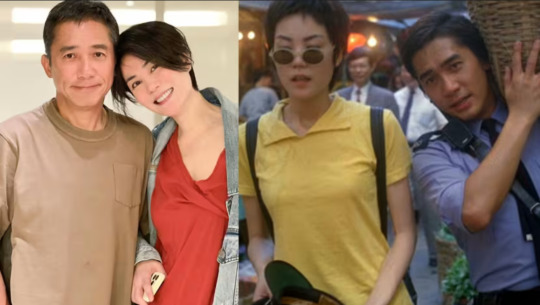
“Long Time No See”: Tony Leung, Faye Wong’s IG Reunion Has Fans Reminiscing About Chungking Express
We're all California Dreamin' now.
by Jonathan Fam
We so were not expecting this. Carina Lau set IG ablaze this afternoon (Oct 25) when she posted a photo of her husband Tony Leung with — wait for this — Faye Wong.
Her caption? A succinct and apt “Long time no see”.
If there’s anyone more low-key than Tony, it’s the enigmatic Faye.
The last time the 54-year-old pop diva was photographed in public was in April, when she was seen, um, roughing it out with other travellers on a crowded airport shuttle in China. Hardly glamorous stuff.
Faye is one of Carina’s closest pals and longtime mahjong kaki. Stories of their mahjong sessions are part of pop culture folklore, with Carina, 57, once saying in an interview that she can easily tell when Faye has a good or bad hand.
Tony, 61, and Faye have starred in three movies together: Chungking Express (1994), Chinese Odyssey 2002, and 2046 (2004).
Their pairing in Chungking Express — he as a lovesick beat cop, and she, a quirky snack bar worker — one of the most iconic in Asian cinema.
Fans, of course, took to comments section to rave about the meetup and share screengrabs of the stars in Chungking Express.
“I wanna cry. Eating chef’s salad and fish and chips to celebrate,” read one comment, an obvious reference to the items Tony’s character Cop 663 orders from Faye’s snack bar.
There were also references to 'California Dreamin'', the Mama and the Papas song that Faye's character listened to repeatedly in the movie.
Most netizens were excited to see Faye on Instagram, with a number of comments praising her for looking as gorgeous as ever.
We don’t know about you, but we’re definitely rewatching Chungking Express after this.
(SOURCE)
----------------------- Legendary actor Tony Leung and singer Faye Wong reunite, capturing the hearts of fans with iconic photo
By Dimsumdaily Hong Kong
25th October 2023 – (Hong Kong)
In a long-awaited reunion, renowned actor Tony Leung and legendary singer Faye Wong recently came together, sparking excitement among their fans.
The elusive Faye Wong, met with Leung, her frequent collaborator, in a gathering that delighted onlookers. In a heartwarming photo, Wong can be seen holding onto Leung’s arm as they lean against each other, both wearing radiant smiles. Despite the passing years, their timeless beauty remains unchanged.
The release of this iconic photo instantly stirred up a frenzy among netizens, evoking nostalgic memories of their previous collaborations in films such as “Chungking Express” and “Chinese Odyssey.”
Wong appeared in a vibrant red top, paired with a denim jacket, exuding a sweet and enchanting aura. Her light makeup accentuated her rosy complexion, while her fresh and breezy short hair added to her overall elegance, earning her widespread praise as a true ageless goddess.
(SOURCE)
----------------------- 'I never thought the day would come': Netizens reminisce over Tony Leung and Faye Wong's reunion
By Syarifah Nadhirah Nearly two decades after their last movie together, Hong Kong veteran actor Tony Leung and Chinese diva Faye Wong have reunited.
Tony's wife, actress Carina Lau, uploaded a photo of the duo today (Oct 25) in a joint Instagram post with Tony.
The iconic reunion comes 19 years after 2046, the 2004 film Tony and Faye starred in together.
"Long time no see," wrote Carina with a heart emoji.
The pair could be seen standing close together, with Faye, 54, leaning her head towards Tony, 61.
Tony, as usual, had a slightly awkward smile.
Besides 2046, Tony and Faye also co-starred in the 1994 hit film Chungking Express and 2002 movie Chinese Odyssey 2002.
Netizens in the comment section reminisced about the past, with many bringing up Chungking Express where the pair played onscreen lovers.
"Chungking Express couple pairing… I looped the movie so many times because of you two" said one netizen.
"I never thought the day would come when I could see the two of you together!" commented another.
Another pleaded: "Please post more videos and photos. It's been a long time since I saw Faye."
Others remarked how Faye looked like she hasn't aged and that the two are "still elegant and charming."
(SOURCE)
14 notes
·
View notes
Text
Ezra Pound the best craftsman


Ezra Pound the best craftsman Ezra Pound the best craftsman as Eliot called him, an article that synthetically explains the linguistic art and poetics of this great poet, with some examples of his writing style and deep literary meaning. I have never known anyone worth a damn who wasn't irascible. Ezra Pound I guess the definition of a lunatic is a man surrounded by them. Ezra Pound A slave is one who waits for someone to come and free him. Ezra Pound The real trouble with war (modern war) is that it gives no one a chance to kill the right people. Ezra Pound I could I trust starve like a gentleman. It's listed as part of the poetic training, you know. Ezra Pound No man understands a deep book until he has seen and lived at least part of its contents. Ezra Pound For Ezra Pound il miglior fabbro. The dedication is drawn from The Divine Comedy, the 14th century epic poem by Dante. The Divine Comedy is divided into three parts - Inferno, Purgatorio, and Paradiso - describing Dante's journey through Hell, Purgatory, and finally Paradise. Eliot returns to this poem throughout The Waste Land. Here, the dedication translates as “the better craftsman,” a reference to Canto 26 of the Purgatorio. Dante refers to the poet Arnault Daniel, but Eliot passes the compliment on to Pound, who helped edit The Waste Land. Eliot returns to the same canto in line 428. More context, from the Cotter translation of the Purgatorio: “O brother, the one I point to with my finger,” He spoke, and pointed to a soul in front, “Was a better craftsman of the mother tongue.” This information is based on a footnote from North (2001). For more on Pound's contributions, see the annotated manuscript of The Waste Land in Eliot (1971). Ezra Weston Loomis Pound was an American expatriate poet, critic and intellectual who was a major figure of the Modernist movement in early-to-mid 20th century poetry. Born in Halley, Idaho, (1885-1972) Pound spent most of his life in Europe. In 1908, in his mid-twenties, he went to London because he wanted to meet the greatest living poet, W.B. Yeats, settled there and became a central figure in the literary and artistic world. He founded and led a poetic movement called "Imagism", which reacted against 'Romanticism' and contributed greatly to the development of "Modernism". For some time he was also involved in "Vorticism", an art movement initiated in 1913 by Wyndham Lewis, which combined cubism and the celebration of the energy and speed of the machine age, very much like Futurism in Italy. In 1909 he published Personae, a collection of poems after the manner of the Victorian poet Robert Browning, whose dramatic monologue technique he employed to speak through the voice of others. A "persona" was the mask worn by Roman actors, and Pound used the mask to avoid subjectivity, which the imagists objected to in Romantic poetry. Gradually, Pound started moving away from the constraints of Imagism, and translated from Anglo Saxon and Chinese verse to explore different forms. In 1917 he also started writing the Cantos, a series of poems inspired by Dante's Divine Comedy and Homer's Odyssey, which he would work on for the rest of his life, while Hugh Selwyn Mauberley (1920) perhaps the first great modernist poem, attacks the destruction of the First World War and initiates one of Pound's main themes: the relationship between civilization and its economic and social basis. From 1920 he lived in Paris with his wife and became part of the new literary scene with expatriate Americans like Gertrude Stein and Ernest Hemingway. In Paris he also met James Joyce, then an obscure writer, and helped him publish Ulysses, which had censorship problems in England.

The art of Ezra Pound In 1929 Pound settled in Rapallo, Italy. He became increasingly concerned with the decline of Western civilization and with the social basis of art in what he believed to be a degenerate economic system. He studied the history of Italian Medieval and Renaissance states and found that Italy had in the past created the ideal conditions for the flowering of great art, while he associated modern credit capitalism with the social and spiritual decline of the present. Unfortunately, Pound's dislike of capitalism led him to Fascism and to Mussolini, who was himself anti-capitalist and who persecuted the Jews, associated with money-lending since the Middle Ages. During the Second World War he made a series of propagandist broadcasts over Radio Rome for which he was later tried in the United States, and confined for 12 years in a hospital for the insane. When he was released, he returned to Italy and died in Venice in 1972. With the Imagist movement, Americans poetry became international, and its leaders, the American Ezra Pound and T.S. Eliot, also became the leaders of European poetry. Imagism as such had a short life-span. But it was to become the most influential poetic movement of the century, just as Pound is now considered one of the most influential Modernist poets. Pound was also a generous encourager of other poets and writers; he edited The Waste Land and published Joyce's Ulysses. Through his translations and essays he made known to English-speaking readers Provencal poetry, the Italian poets of the Stil novo, Japanese dramatic literature and Chinese classical poetry. Finally, his critical essays con-tributed to the definition of 'Modernism' as a movement and introduced new standards of objectivity in the evaluation of literature. The Modern Age Cantos Imagism When Pound went to London he made common cause with a small group led by the philosopher T.H. Hume. They called themselves imagists and announced a new kind of poetry, which Pound summarized in a Manifesto: 1) To use the language of common speech, but to em-ploy also the exact word, not the merely decorative word. 2) To create new rhythms - as the expression of new moods. We do not insist on 'free verse' as the only method of writing poetry... We do believe that the in-dividuality of a poem may often be better expressed in free verse than in conventional forms. 3) To allow absolute freedom in the choice of subject. 4) To present an image (hence the name 'Imagist'). We are not a school of painters, but we believe that poetry should render particulars exactly and not deal in vague generalities, however magnificent and sonorous. 5) To produce poetry that is hard and clear, never blurred or indefinite. 6. Finally, most of us believe that concentration is the very essence of poetry. A multicultural collection of poems The following poem by Pound has become famous as an example of the principles declared in the Manifesto. The poem describes a moment of intense emotion at seeing beautiful faces in a station of the Paris underground. The images condense the emotion in two parallel pictures with great economy of words, and using the language of common speech: In a Station of the Metro The apparition of these faces in the crowd; Petals on a wet, black bough. From "Poems of Lustra", 1913 In 1914 Pound abandoned the movement. Imagism was only a step on the way to Modernism, because images alone offered too limited possibilities for poetry. But its insistence on economy and free-verse continued to be valuable. Starting in 1917, Pound worked on the Cantos for the rest of his life. The Cantos, 140 loosely connected poems, have their source in Dante's Divine Comedy, as their name declares, and on the Odyssey, a model for Pound's exploration of contemporary civilization. Some of Dante's persons, like Brunetto Latini, figure in them, while many episodes have the Odyssey as a starting point. Pound shows a vivid awareness of the past. Like most great modernists (Yeats and Eliot), he looked into the past for useful literary material, for principles of conduct and for comparison with the present. As a result the Cantos are a multi-cultural work: besides the references to Dante and the Odyssey, there are also references to the Old Testament, Rimini in the 15th century under Sigismondo Malatesta, whom he considered the ideal, benevolent despot, Confucius, the United States at the time of Jefferson, Medieval England and Provence, to mention but a few. One of the main preoccupations expressed in the Cantos is economic. Pound believed that usury was at the basis of contemporary credit capitalism, which he considered the source of cultural and social disintegration. The usurer, be it an individual money-lender or a bank, charges interest, and interest, which is not worked for, creates false values, not just in economics, but also in life and art. The groups of cantos concerned with usury were written in the 1930s, when Pound was in Rapallo. In Canto XI of the Inferno, Dante asks Virgilio why usury is considered one of the most serious crimes against nature. Virgilio answers that nature takes its origin directly from God's mind and art (doings). Humanity imitates nature and art (work), like a schoolboy imitating his master. But usurers despise nature and art and refuse to live by the fruits of nature and of work. They live by the rates of interest that come from money-lending: "Filosofia, mi disse, a chi la' ntende nota, non pure in una sola parte, come natura to suo corso prende dal divino intelletto e da sua arte; e se tu ben la tua Fisica note, tu troverai, non dopo molte carte, che l'arte vostra quella, quanto pote, segue, come'l maestro fa'l discente; si che vostr'arte a Dio quasi e nipote. Da queste due se tu ti rechi a mente to Genesi dal principio, convene prender sua vita e avanzar la gente; e perche l'usuriere altra via tene, per se natura e per la sua seguace, dispregia, poi ch'in altro pon la speme." Philosophy, he (Virgil) told me, for those who understand it, explains in more than one place, that Nature takes its origin directly from God's Mind and from his Art (doings); and if you read Aristotles's Physics, you'll soon discover that your (human) art imitates Nature as it can, like a schoolboy his master. So that your art can be called God's grandchild. From these two (Art and Nature) if you remember the beginning of Genesis, man should get his bread and promote prosperity to all. But the usurer chooses another way; he despises Nature and Art because he places his hopes elsewhere. With usura Canto XLV With usura hath no man a house of good stone each block cut smooth and well fitting that design might cover their face, with usura hath no man a painted paradise on his church wall harpes et luz or where virgin receiveth message and halo projects from incision, with usura seeth no man Gonzaga his heirs and his concubines no picture is made to endure nor to live with but it is made to sell and sell quickly with usura, sin against nature, is thy bread ever more of stale rags is thy bread dry as paper, with no mountain wheat, no strong flour with usura the line grows thick with usura is no clear demarcation and no man can find site for his dwelling. Stonecutter is kept from his stone weaver is kept from his loom WITH USURA wool comes not to market sheep bringeth no gain with usura Usura is a murrain, usura blunteth the needle in the maid’s hand and stoppeth the spinner’s cunning. Pietro Lombardo came not by usura Duccio came not by usura nor Pier della Francesca; Zuan Bellin’ not by usura nor was ‘La Calunnia’ painted. Came not by usura Angelico; came not Ambrogio Praedis, Came no church of cut stone signed: Adamo me fecit. Not by usura St. Trophime Not by usura Saint Hilaire, Usura rusteth the chisel It rusteth the craft and the craftsman It gnaweth the thread in the loom None learneth to weave gold in her pattern; Azure hath a canker by usura; cramoisi is unbroidered Emerald findeth no Memling Usura slayeth the child in the womb It stayeth the young man’s courting It hath brought palsey to bed, lyeth between the young bride and her bridegroom CONTRA NATURAM They have brought whores for Eleusis Corpses are set to banquet at behest of usura. N.B. Usury: A charge for the use of purchasing power, levied without regard to production; often without regard to the possibilities of production. (Hence the failure of the Medici bank.) Pound's The Cantos contains music and bears a title that could be translated as The Songs - although it never is. Pound's ear was tuned to the motz et sons of troubadour poetry where, as musicologist John Stevens has noted, "melody and poem existed in a state of the closest symbiosis, obeying the same laws and striving in their different media for the same sound-ideal - armonia." In his essays, Pound wrote of rhythm as "the hardest quality of a man's style to counterfeit." He challenged young poets to train their ear with translation work to learn how the choice of words and the movement of the words combined. But having translated texts from 10 different languages into English, Pound found that translation did not always serve the poetry: "The grand bogies for young men who want really to learn strophe writing are Catullus and François Villon. I personally have been reduced to setting them to music as I cannot translate them." While he habitually wrote out verse rhythms as musical lines, Pound did not set his own poetry to music. You can also read: Ezra Pound quotes and aphorisms Ezra Pound thoughts and reflections T.S. Eliot quotes and aphorisms T.S. Eliot thoughts and reflections Quotes by authors Quotes by arguments Essays with quotes Thoughts and reflections News and events Read the full article
2 notes
·
View notes
Text
Events 4.13 (after 1950)
1953 – CIA director Allen Dulles launches the mind-control program Project MKUltra. 1960 – The United States launches Transit 1-B, the world's first satellite navigation system. 1964 – At the Academy Awards, Sidney Poitier becomes the first African-American man to win the Best Actor award for the 1963 film Lilies of the Field. 1970 – An oxygen tank aboard the Apollo 13 Service Module explodes, putting the crew in great danger and causing major damage to the Apollo command and service module (codenamed "Odyssey") while en route to the Moon. 1972 – The Universal Postal Union decides to recognize the People's Republic of China as the only legitimate Chinese representative, effectively expelling the Republic of China administering Taiwan. 1972 – Vietnam War: The Battle of An Lộc begins. 1975 – An attack by the Phalangist resistance kills 26 militia members of the Popular Front for the Liberation of Palestine, marking the start of the 15-year Lebanese Civil War. 1976 – The United States Treasury Department reintroduces the two-dollar bill as a Federal Reserve Note on Thomas Jefferson's 233rd birthday as part of the United States Bicentennial celebration. 1976 – Forty workers die in the Lapua Cartridge Factory explosion, the deadliest industrial accident in modern Finnish history. 1996 – Two women and four children are killed after Israeli helicopter fired rockets at an ambulance in Mansouri, Lebanon. 1997 – Tiger Woods becomes the youngest golfer to win the Masters Tournament. 2014 – Three people are killed in a shooting in Overland Park, Kansas. 2022 – The Russian cruiser Moskva is attacked by two Ukrainian two R-360 Neptune anti-ship missiles and sinks into the Black Sea near Snake Island. 2023 – The house of Jack Teixeira is raided in an investigation into leaked Pentagon documents; he is arrested on the same day. 2024 – Six people and the perpetrator are killed and twelve others injured in a mass stabbing at Westfield Bondi Junction shopping centre in Sydney, Australia.
0 notes
Text
Diabolos Est Machina Part 2: The Devil Is In the Details
Special thanks to my sister, who helped inspire me to do this series.

Welcome back to Diabolos Est Machina, Last time, we did some defining of terms when it comes to artificial intelligence. I don't remember if I had addressed it in the last post, but I will say it here just in case:
Artificial intelligence is considered to be a part of automation.
Something I also forgot to mention was that video games also employ some form of AI. It's mostly an aside though, as the systems that games use tend to be very rudimentary compared to what is more generally known as AI.
So today, before we actually tackle the big Devil itself (yes I know, I said I'd talk about the Devil Gundam; we'll get there by Halloween), we are going to look at the history of automation in fiction. We're also going to take a look at three different examples of AI-adjacent characters in fiction.
A (Very) Abbreviated History of Robotics in Fiction

Fictional robots and artificial humans are some of the oldest stories in the collective canon of humanity. From what I could tell, the earliest cases of the Kourai Khryseai that were made by Hephaestus as his assistants. Per the Wikipedia link above, robots and artificial humanoids have also existed in all sorts of cultures, including but not limited to Greek, Egyptian, Chinese, and Indian cultures.
As we head into the 1800's and the 1900's, we would see a lot of pivotal stories come about that are associated with robots and automation such as Frankenstein (the first science fiction story, which is all about creating artificial life no less), Rossum's Universal Robots (which is where we get the word Robot from), Metropolis (which is the first portrayal of a robot on film), and I, Robot (which is where we get the Three Laws of Robotics from).
But we're talking about Artificial Intelligence though and those are just robots. Which is true, but these stories would help to pave the way for a certain film releasing in the 60's. And with that new film, the world would be introduced to a new character (and our first case study).
Case 1: HAL-9000

"I am putting myself to the fullest possible use, which is all I think that any conscious entity can ever hope to do." -HAL
Full disclosure: It's been a while since I last watched 2001: A Space Odyssey, so my recollection of what happens in the movie outside of the broad strokes will be a bit
I believe it is impossible to really talk about AI characters without mentioning 2001: A Space Odyssey's HAL-9000. HAL is known for his cold and impersonal appearance and mannerisms, with the only major feature that defines the character is a single modem with a red LED for a face. HAL is also slavishly devoted to the mission of the Discovery One.
One of the most important concepts introduced with HAL is the idea of the AI as a killer entity. Note that this is not the first example of this type of character, but I feel confident that most people tend to think of HAL as the go-to example of the killer AI character alongside Terminator's Skynet.
When it comes time for him to betray Dave and Frank, HAL justifies this by saying the mission is more important than the safety of the crew. When Dave confronts HAL and tries to shut the AI down, HAL pleads with Dave not to do it. It is unknown to the audience whether or not HAL actually feels scared or is using it as a defense mechanism to prevent David from shutting him down.
As I said earlier, HAL's purpose is to complete the mission and will stop at nothing to see that it is done. This is important to remember, as HAL otherwise largely functions like a highly advanced computer program. A computer program that can feel emotions or, depending on who you ask, mimic the idea of feeling emotions.
Case 2: Fuyo 0 AKA Tama

"When she's surround by smiles, that's when she's at her best." -Gintoki Sakata
Could I have talked about a different character like Astro Boy? Yes.
Have I read or watched Astro Boy? No, so we're talking about Tama instead.
Gintama gives us a great foil to 2001's HAL in the form of the robot maid Tama. Originally designated Fuyo 0 as a part of a line of robot maids (robot maids that largely fetish machines, I might add), Tama is unique in that she can experience emotions. This is referred to in-universe as The Seed, which is an easy way to handwave how Tama is capable of experiencing emotions.
What is interesting to me is that Tama is the exact opposite of HAL. Whereas HAL's primary purpose is to complete his mission at all costs, Tama does not have a purpose for existing outside of being a replacement daughter for her creator (hence why she can experience emotions like sadness or happiness). Tama eventually extrapolates that her purpose is to help others in any way she can. This makes for another contrast between her and HAL in that Tama accepts her fate as being ultimately disposable, unlike HAL who views his continued existence as being of critical importance to his mission.
And I get that Tama is a character in a gag series, so a lot of her characteristics are largely played for laughs. But I do think it's worth highlighting that the two contrast each other pretty well. It showcases just how differently an AI/AI-adjacent character can be portrayed throughout fiction. There are all sorts of examples of these kinds of characters. Shodan, Cortana. But there is one last case study I'd like to look at. And for this one, I want to look at a character similar to the Devil Gundam itself.
Case 3: Mobile Armor Hashmal

Before I close out on this section, it would be foolish of me not to mention a character like Iron-Blooded Orphans' Mobile Armor Hashmal.
I only mentioned them briefly, but the Three Laws of Robotics is, despite being created for a work of fiction, something that is treated very seriously in the world of robotics and automation. Granted, it is something that is impossible to actually implement them into code due to the ambiguities of language, but the Three Laws serve as a useful backbone for a lot of AI and robotics ethics.
For reference, these are the Three Laws:
The First Law: A robot may not injure a human being or, through inaction, allow a human being to come to harm.
The Second Law: A robot must obey the orders given it by human beings except where such orders would conflict with the First Law.
The Third Law: A robot must protect its own existence as long as such protection does not conflict with the First or Second Law.
These laws are nice, but they are not fixed. The Three Laws are guidelines that should be adhered to, and it becomes a problem when a machine is made with the express purpose of killing.
And Hashmal's entire purpose is to kill.
Whereas with both HAL and Tama we can communicate with both of them, Hashmal cannot talk. It is, first and foremost, a killing machine. Hashmal, unlike even HAL, can come off as downright alien, especially since we witness Hashmal's awakening well after the time it was created. There's no parlaying with a being that looks at you like how a hawk looks at a mouse. When it comes to Hashmal, there is only death.
Conclusion
And those are three very specific examples of AI-related characters in fiction. As I had said at the beginning, AI and robotics tend to go hand in hand. Next time, and gods willing I can get this done on Halloween, we will finally cover the Devil Gundam!
1 note
·
View note
Link
The ground shakes. Paintings tilt. Walls crack. Rubble may fall. On Earth, we understand how and where these events happen due to the discovery of plate tectonics – the continental crust’s creation, movement, and destruction. However, when astronauts placed seismometers on the lunar surface during NASA’s Apollo mission era, those instruments recorded quakes on the Moon. In the 1970s, the Viking landers also recorded quakes on the surface of Mars. Since neither of these worlds has plate tectonics, scientists set about collecting more data to understand the phenomena, which led to the recent NASA InSight lander. Now, a new paper in Geophysical Research Letters explains how the largest recorded seismic event on Mars provided evidence for a different sort of tectonic origin — the release of stress within the Martian crust. On Wednesday, May 4, 2022, InSight recorded a record-breaking magnitude 4.7 marsquake with an epicenter about 2,200 kilometers away from the lander. The resulting tremors shook the planet for the next six hours. The event was large, but scientists had no reason to believe the cause was anything different from the usual meteoroid impact. After all, InSight had recorded no fewer than eight impact-related quakes, the two largest of which resulted in separate craters about 150 meters in diameter. This new event – cataloged as S1222a – generated a quake energetic enough for the resulting crater to be on the order of 300 meters in diameter with a potential blast zone nearly 200 kilometers wide. This spectrogram shows the largest quake ever detected on another planet. Estimated at magnitude 5, this quake was discovered by NASA’s InSight lander on May 4, 2022, the 1,222nd Martian day, or sol, of the mission. Credit: NASA/JPL-Caltech/ETH Zurich All three events had several similarities, including long-period surface waves. There were, however, differences in the wave data types collected. Lead author Benjamin Fernando from the University of Oxford still suspected an impact as the cause of S1222a. He gathered up a team to find the crater, requesting help from a number of organizations, including the European Space Agency, the Chinese National Space Agency, the Indian Space Research Organisation, and the United Arab Emirates Space Agency, all of whom have or had missions in orbit around the red planet. These orbiters have been collecting a wide range of images, covering the entire visible spectrum as well as some near-infrared (Mars Odyssey) and ultraviolet (Emirates Mars Mission and MAVEN) bands. InSight’s seismometer, SEIS, the Seismic Experiment for Interior Structure. Credit: NASA/JPL The team ended up taking several months to search the nearly 144 million square kilometers of Martian surface using low- and medium-resolution images from all of their respective orbiters. No new craters in the correct size were discovered. Nor did they find any signatures of potential new craters such as a dust cloud from the impact or a dark patch representing the expected blast zone. Without the mechanics of plate tectonics, the team concluded that the 4.7 temblor had to have been caused by the “release of enormous tectonic forces within Mars’ interior”. As Fernando explains, “We still think that Mars doesn’t have any active plate tectonics today, so this event was likely caused by the release of stress within Mars’ crust. These stresses are the result of billions of years of evolution; including the cooling and shrinking of different parts of the planet at different rates.” While the imagery ruled out an impact cause for this marsquake, further analysis of the wave data is necessary to understand fully the nature of Mars’ tectonic mechanics, and that analysis is ongoing. Unfortunately, NASA’s InSight reached the end of its mission in December 2022, so now the data collection focus will be on upcoming lunar missions from another assortment of international organizations. We look forward to more collaborations in the quest for understanding our solar system. Original Source: University of Oxford press release The post “The Big One”: The Most Powerful Marsquake Ever Detected appeared first on Universe Today.
0 notes
Text
Critical Annotation
My research focuses on developing my concept of Daoism and my painting practice. In the concept parts, I investigate different contemporary artists and how to cross-fertilise Daoism in their artwork. In terms of visual research, I study painters from distinct times and cultural backgrounds. I also seek meaning in artworks that use the same elements as me in their creation.
Daoism reminds people that it is narrow minded to judge the world subjectively and from the height of the universe of heaven and earth and the height of human society. (1) Cai Guo-Qiang’s childlike imagination transforms the Daoist cosmological perspective into a series of Projects for extraterrestrials. (2) Xu Bing’s Gravitational Arena transforms this cosmological perspective into a reading perspective that the audience cannot reach that transcends the space of the gallery. (3) From a cosmic view of the Earth, all of us are the travellers in the universe. There will be no misunderstanding between cultures. Letting everything free wander is my approach to pursuing the freedom of spirituality as well as my main creative methodology.
Another important concept at the heart of the Daoist universe is that everything lacks an enduring essence. In Cai Guo-Qiang’s The Century with Mushroom Clouds, Cai’s miniature mushroom clouds symbolise this impermanence. (4) The record in Song Dong’s Water Diary disappears as the water evaporates, which visualises the artist moving along the path of life to the Dao. (5) This changeable essence of Dao has heightened my desire to capture more beautiful moments and experience the eternal world for an instant. The vivid brushstrokes and those moving motifs such as clouds, raindrops, wind, or flowers are my visual representation of aesthetic moments.
I depict various circles throughout my projects. Lindy Lee creates thousands of delicate holes in Secret World of a Starlight Ember inspired by the milky silver of the cosmos. (6) The first circle in Song Dong’s Round represents his love for his daughter. (7) I think those bubbles, which have no beginning and no end, are a symbol of the universe and are perfect to represent how I feel when I experience the present moment in fullness.
The gestures inHuang Yongping’s Thousand-Armed Bodhisattva are a reflection and examination of the diverse and complex cultural contexts of the contemporary world and a temporal and spatial coordinate for contemporary art. (8)The gesture inShen Yuan Gazelle represents the artist’s sorrow and loneliness. (9) Huang Yongping and Shen Yuan are soulmates. This work was made after Huang Yongping's sudden death. I think sometimes the partial appearance of a body part is better than the whole human body, leaving a rich space for imagination.
In terms of visual research, Guo Xi’s ‘three distances’ of the principle of cavalier perspective and Min Qiji’s illustration of The Story of the Western Chamber inspired me to use traditional Chinese painting construction in my pictorial space. (10) Wolfe Von Lenkiewicz borrows from classic oil painting construction, encouraging me to try larger painting compositions and content narratives. (11)
Reference:
http://worldinsand.blogspot.com/2013/10/blog-post_18.html
Schama, Simon. Odyssey and Homecoming: Cai Guo-Qiang. DelMonico Book·D.A.P., New York, 2021.
https://www.xubing.com/en/work/details/686?year=2022&type=year#686
Thomas, Taliesin. “Explosion into Emptiness: Daoist Reverberations in the Art of Cai Guo-Qiang.” Journal of Daoist Studies 16 (2023): 105-126. doi:10.1353/dao.2023.0005.
Ortis, Jessica (2011) “The Art of Being: A Study of the Relationship between Daoism and Art,” Journal of Undergraduate Research at Minnesota State University, Mankato: Vol. 11 , Article 11. Available at: https://cornerstone.lib.mnsu.edu/jur/vol11/iss1/11
https://www.timeout.com/sydney/art/secret-world-of-a-starlight-ember
https://mp.weixin.qq.com/s/eWRW107jLiBidOudqdsmOw
http://www.redbrickartmuseum.org/exhibitions/thousand-armed-guanyin/?lang=en
http://www.redbrickartmuseum.org/exhibitions/shen-yuan-angling/?lang=en
Wu Hung. Space in art history. Shanghai: Shanghai renming chubanshe: 2018.
https://www.chinesearthistory.com/xixiangj
11. https://www.chinesearthistory.com/xixiangjihttps://wolfevonlenkiewicz.com/about/
0 notes
Note
Greetings! I hope you're having an at least decent weekend. Is it just me or is Stephen Chow involved in a lot of jttw/swk centered media? & do you have anything to say about any of Stephen Chow's jttw/swk centered work?
Stephen Chow WAS Sun Wukong in what could be considered the most iconic Sun Wukong that changed the game. I'm not kidding that there could be a butterfly effect on how Stephen Chow's Wukong in the Chinese Odyssey became such a classic we see how it has affected games, shows, and movies even years later. Dare I say it but I think Stephen Chow could have been just as influential to Wukong's development in modern media as much as even Liu Xiao Ling Tong with how IMPACTFUL his Wukong was.

I have to say that Stephen Chow does have a certain scene of humor that you see in all his movies, not just Journey to the West. He can be raunchy, violent, and nonsensical so I would say that his style of movies might not land with everyone but Stephen Chow undoubtedly always puts a lot of heart into his characters which is what really makes people connect with his movies. He is a master of incorporating meaningful connections through the most ridiculous and insane situations that humans could find themselves in and that is part of his charm seeing both the humor and the tragedy in life as they often go hand and hand. I would suggest reading more about his style here since I think it puts into words how his art form is expressed.
But there can be a fascinating conversation to say just HOW much his Sun Wukong has influenced even modern Journey to the West media. Chinse Odessey was nearly 30 years ago and yet its impact is still being seen today in movies that are directly related to his films, versus movies and shows that he is directly or indirectly involved in today.
Journey to the West Conquering the Demons (2030) (tv remake on Chow’s Wukong)
Black Myth Wukong (2024)
The Monkey King (2023)
A Chinese Odyssey 1 (2022)
A Chinese Odyssey - Origin (2022)
Journey to the West - ARPG (2019)
Bio of Wukong (2017)
The Legend of Sun Wukong (2017)
A Chinese Odyssey TV series (2017)
Journey to the West Demon Strikes Back (2017)
A Chinese Odyssey Part Three (2016)
Honor of Kings (2015)
Taste of Love (2015)
Journey to the West Conquering the Demon (2013)
Asura Online (2010)
Even in movies that he is NOT involved in like Monkey King: The One and Only (2021) 大圣无双 where the Wukong actor is basing his performance clearly on Demon Strikes Back (2017) Wukong. Not to mention nearly EVERY SINGLE Wukong x SO plot line where the SO dies in the end could be traced back to Chinese Odyssey. If you hate how much Wukong's love interests are killed off in media, you can somewhat blame Stephen Chow, not for doing it first, but for doing it WELL and then dozens of directors for years to come trying to recapture that magic but falling short of what made people love that tragic romance in the first place.
Chinese Odessey was made in 1995 and led to the light novel Bio of Wukong which was made in 2000 and at least 4 more movies and its own TV show. The Bio of Wukong was so popular that it led to the inspiration of Asura Online game based is the story and its own movie Immortal Demon Slayer. Stephen Chow continued to make his own movies Conquering the Demon and Demon Strikes Back. He also goes on to help produce Monkey King 2023 and even makes plans to help produce an entire TV series based on his own universe. Asura Online was worked on by Game Science who continued to work on the creation of Black Myth Wukong. This isn't even to mention the spin-offs, sequels, and prequels to Chow's movies and still how they are influencing directors today.
I can't express how much Chow has impacted the very image of Sun Wukong from being a fighter to a tragic hero. I even took from an ENTIRE CHPATER from Transforming Monkey: Adaptation and Representation by Hongmei Sun bout the CULTURAL impact that fans had with Chinese Odessey and how it became such a cult classic. He was the one to really reshape what Wukong could mean to people, not just a hero in an action movie, but a tragic figure that is forced to give up his individualism for the sake of saving the world because no one else can. That the burden of being 'Sun Wukong' can be relatable to anyone and anyone can see their own struggles with how Wukong tries not just to fight demons, but also fight himself.
I have so many feelings on the intricacies of how Wukong's character changes throughout each generation and each audience across countries and what he means to each new audience but never loses what makes him so beloved and keeps him still going strong after 400 years. And I think that Stephen Chow plays a huge and critical part in how Wukong has changed yet again in the public eye. Wukong going from a pure heroic figure to now a tragic hero who has all the power in the world but still finds himself falling short of what he desires in life. I think that this was a vital step in show the complexity and having more directors and the audience toy with the notion of Wukong's internal battle with his identity versus him always just fighting physical battles.




I will say that Chow's influence did lead to the popularity of the Journey to the West Conspiracy Theory which I am not personally a fan of. It is not that it can't be fun or interesting but moreso I believe that this theory has been drawn out far too long in the past 20 years and that it is time for a new nuance perspective to take its place. Genres have waves of new tropes and cliches and I do believe the 'heaven bad, yaoguai misunderstood' has been played out a tad too long to be charming anymore. I think this was a vital step in Wukong’s and Journey to the West adaptions but I also believe that now more can be built upon this premise to allow for more creative ideas that reflect a more modern audience.
I think that the audience that has grown up with Chow's work (Chinese Odessey at least) is now at the age where they can produce and create their own material and we are still seeing how this audience is echoing the same statements of Chow's Tragic Hero standpoint. I don't know what else I can say that I haven't said before but the sheer magnitude of changing a character's image is shocking and I hope that we see what new form Sun Wukong shall take!
#sun wukong#anon ask#anonymous#anon#jttw#journey to the west#xiyouji#ask#monkey king#jttw17#jttw13#immortal demon slayer#bio of Wukong#black myth#black myth wukong
90 notes
·
View notes
Text
Wo Long: Fallen Dynasty - A Captivating Journey into Classic Chinese Legends
Embark on an awe-inspiring odyssey to ancient China, a realm engulfed in turmoil and devastation, during the tempestuous year of 184 AD amidst the gripping grasp of the Later Han Dynasty. Koei Tecmo, the venerated artisans of mesmerizing interactive tales, have fervently immersed themselves in the enchanting tapestry of the classical Chinese opus, Romance of the Three Kingdoms, culminating in their latest opus - Wo Long: Fallen Dynasty. While the Dynasty Warriors series has long embraced the saga's legendary narrative, Wo Long breathes new life into the well-trodden epic, artfully illustrating the company's boundless audacity and ingenuity in vividly reimagining this age-old fable. Wo Long: Fallen Dynasty, a meticulously honed masterpiece of digital artistry, ardently beckons players to traverse a shadowed and elevated realm of historical events, evocative of both the Romance of the Three Kingdoms and Dynasty Warriors sagas. Nestled in the far reaches of ancient China, the game ingeniously bequeaths players an immersive and mesmerizing sojourn, seamlessly intertwining the essence of the Soulslike genre with the opulent lore of the Three Kingdoms epoch. Immerse yourself entirely in an original and gripping narrative, assuming the mantle of an anonymous foot soldier destined to ascend as a mythic paragon. As the anointed one, you shall bear witness to cataclysmic events with theatrical grandeur, dauntlessly confronting diabolical forces and forging a transcendent destiny that spans the ethereal realms of time and space. Thoroughly prepare your spirit to embark on this epochal pilgrimage and intently witness the titanic collision of empires, as you ardently etch your indelible mark upon the annals of history.

A Unique Creative Take on a Familiar Tale:
In the immersive world of Wo Long: Fallen Dynasty, players can fully embrace the awe-inspiring narrative and gameplay that sets it apart from its predecessors in the Dynasty Warriors series. If you're looking to enhance your gaming experience further, consider exploring the captivating Romance of the Three Kingdoms through this game's innovative storytelling and gameplay mechanics. Don't forget, you can also buy Xbox games like Wo Long: Fallen Dynasty to dive into the rich history of ancient China and embark on an enthralling journey!

Immersive Soulslike Experience:
Drawing inspiration from Koei's previous successful Soulslike venture, Nioh, and its sequel, Wo Long: Fallen Dynasty, which offers an exhilarating experience akin to a masterful dance of intense battles, requiring strategic thinking and precise execution to overcome formidable foes, players can enhance their gaming journey by exploring this captivating world. If you're looking to buy Xbox games that provide an adrenaline-pumping experience like no other, Wo Long: Fallen Dynasty should be on your radar.

The Allure of Ancient China:
One of Wo Long's greatest strengths is its ability to transport players back to the captivating world of ancient China. From the beautifully designed landscapes to the intricately detailed character models, every aspect of the game showcases the developer's dedication to recreating an authentic and visually stunning setting. The vibrant colors and the attention to historical accuracy add to the game's allure, making players feel like they are an integral part of this mesmerizing period.

A Tale of Heroes and Legends:
In Wo Long: Fallen Dynasty, players assume the roles of legendary heroes and influential figures from the Three Kingdoms era. The game allows players to embody these iconic characters and experience the epic battles that shaped the course of Chinese history. With its compelling narrative and rich character development, players will form deep connections with the heroes they control, enhancing the emotional investment and enjoyment of the game.
Immersing in the Three Kingdoms Era:
Wo Long: Fallen Dynasty excels in providing an unparalleled immersion into the Three Kingdoms era. The game's attention to historical detail, including accurate depictions of iconic locations and famous battles, gives players an authentic taste of ancient China. The meticulously crafted world encourages players to explore and learn more about this period, fostering a genuine connection to the story and the characters they encounter.

Wo Long: Fallen Dynasty - An Epic Tale of Chaos, Demons, and Heroes
The Story
Step into the shoes of a humble and anonymous militia soldier as destiny beckons you forth in Wo Long: Fallen Dynasty. The stage is set in the tumultuous Three Kingdoms period, where demons roam freely, and historical figures wage wars for supremacy. Despite its inspiration from other renowned titles like Onimusha and Nioh, Wo Long: Fallen Dynasty sets itself apart with its uniquely woven narrative and mesmerizing storytelling. As players traverse through the enthralling storyline, they encounter a myriad of heroes and villains, each leaving an indelible mark on the unfolding tale. From powerful warlords to ancient sorcerers, every character possesses a distinct personality and motive, adding depth and intrigue to the plot. This engaging narrative structure, while restrained, cleverly guides players through a series of linear missions, occasionally supplemented by compelling side quests that breathe life into the game world. The game embraces its historical setting with utmost respect, meticulously recreating the rich tapestry of the Three Kingdoms era. However, Wo Long: Fallen Dynasty takes bold creative liberties, infusing the narrative with a demonic slant. The clash between warring factions and the malevolent invasion of demonic forces creates a seamless blend of history and fantasy, fueling players' excitement as they are drawn deeper into the epic saga.

The Action
Combat is the heart and soul of Wo Long: Fallen Dynasty, and it leaves players exhilarated with its fast-paced, dynamic, and satisfying mechanics. Drawing inspiration from the likes of Dynasty Warriors and Musou games, the action in Wo Long is nothing short of breathtaking. Engage in intense battles, unleashing an array of deadly martial arts skills and powerful weapon techniques against hordes of enemies and fearsome demons. The strategic depth of combat is further enhanced by the diverse roster of characters, each wielding their unique abilities and fighting styles. Mastering the intricacies of these characters adds an exciting layer to the gameplay, empowering players to tailor their approach to different situations. Whether you prefer lightning-fast strikes or brute force, Wo Long: Fallen Dynasty accommodates various playstyles, keeping the gameplay fresh and engaging throughout.

Setting and Design
Wo Long: Fallen Dynasty excels in crafting a visually stunning and atmospheric world, faithfully recreating the essence of ancient China. Meticulously detailed environments, from sprawling battlefields to tranquil villages, immerse players in an authentic historical setting. The visual fidelity of the game is nothing short of remarkable, allowing players to lose themselves in the captivating sights and sounds of this ancient land. While not an open-world title, Wo Long: Fallen Dynasty's linear mission structure creates a focused and narrative-driven experience. This approach enables the developers to deliver a tightly-knit storyline, allowing players to witness the repercussions of their actions on the world and its inhabitants. The absence of an open world does not detract from the game's appeal, as the story unfolds seamlessly, drawing players deeper into the heart of the saga.

Conclusion
Wo Long: Fallen Dynasty triumphs as a groundbreaking video game that ingeniously fuses the historic saga of Romance of the Three Kingdoms with the exhilarating Soulslike genre. Unlike its genre peers, Wo Long fearlessly forges an innovative path, offering players a refreshingly immersive experience that leaves them yearning for more. By weaving supernatural elements into the backdrop of the Three Kingdoms era, the game sets itself apart from the rest, delivering an unparalleled and captivating journey. Its emotionally resonant narrative and focused gameplay prove to be a masterstroke, drawing players deep into the characters' struggles. Koei Tecmo's exceptional creative prowess shines through, setting a new standard for harmoniously blending historical legends with engaging gameplay. Embark on an extraordinary adventure in ancient China, and unleash your inner hero in the epic tale of chaos, demons, and heroes that awaits in Wo Long: Fallen Dynasty.
1 note
·
View note
Text
Chapter Head Art for Maybe Sprout Wings (Full set)
I have had just, So Much Fun working on these. This story really is built on such a great concept, and with such fantastic worldbuilding, and with action so thoroughly in tune with its themes that it really does reward digging into. @moorishflower's writing kills me in the best of ways (and in the sleep deprivation kind of ways but I have no regrets), and designing them was a great time. And on top of that, everyone here has been just, so lovely, so I'm very excited to post the full set of chapter head illustrations!
Stylistic consistency continues to elude me, but hopefully these look like a matched enough set regardless. Cursive titles are the chapter titles, block print is my own title for the illustration. Just for fun, and in tribute to the (probably truly unhinged) amount of time I spent thinking about Symbolism while making these, I'm including one selected Fun Fact relevant to my thoughts on some part of each of these at the bottom of this post in case that interests anyone!
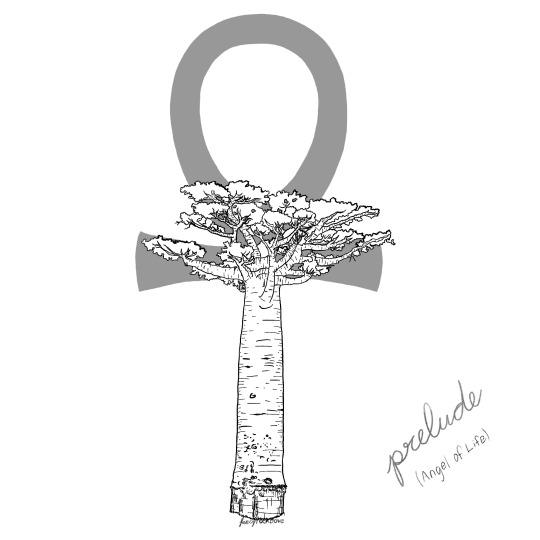
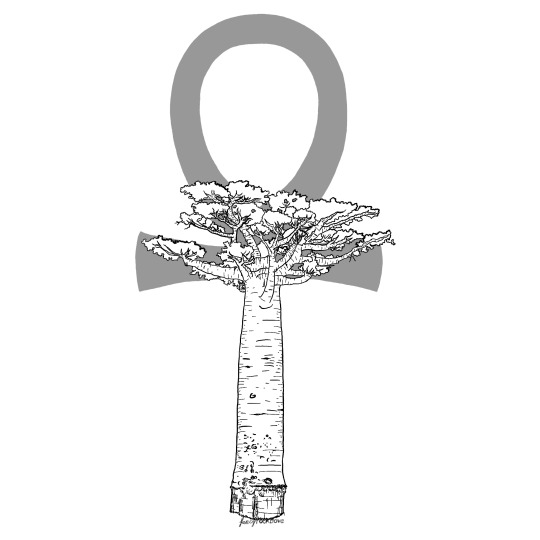
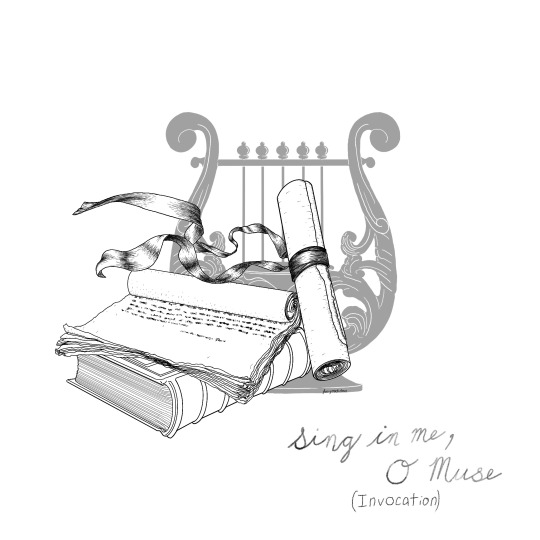





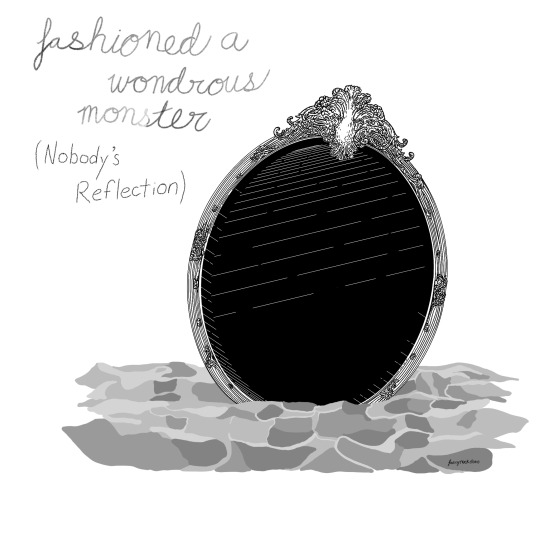
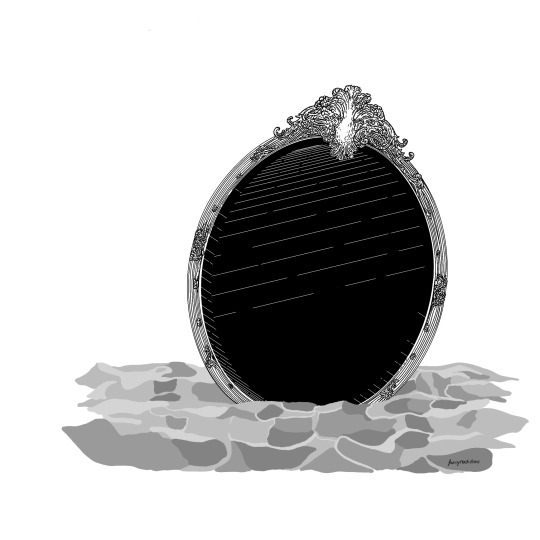
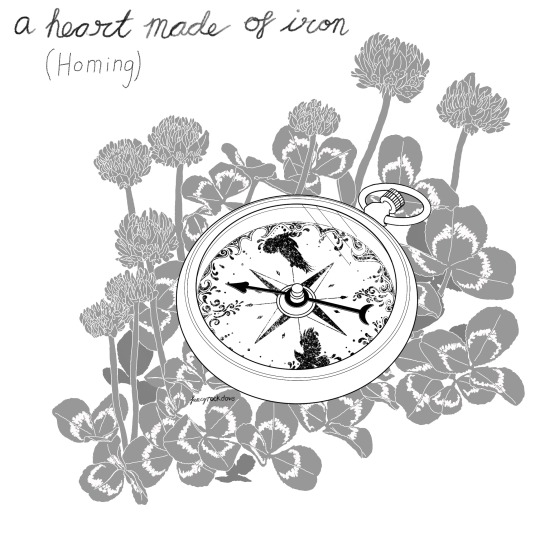

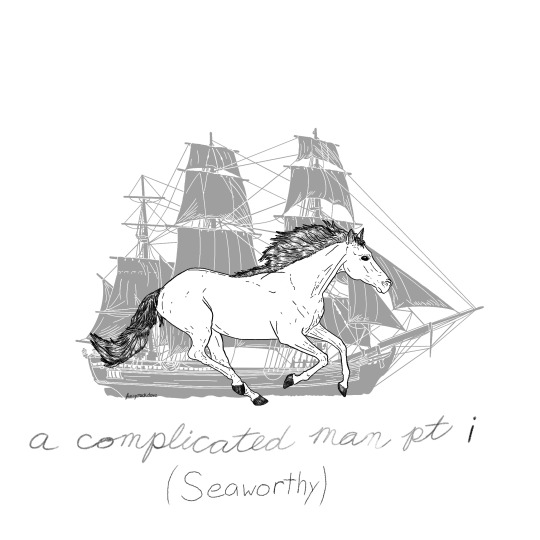
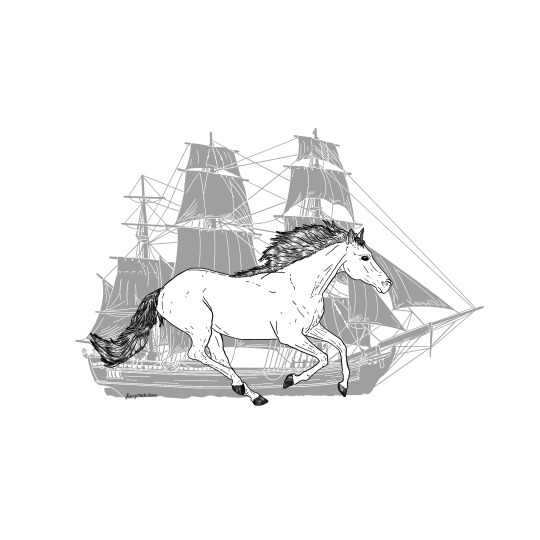



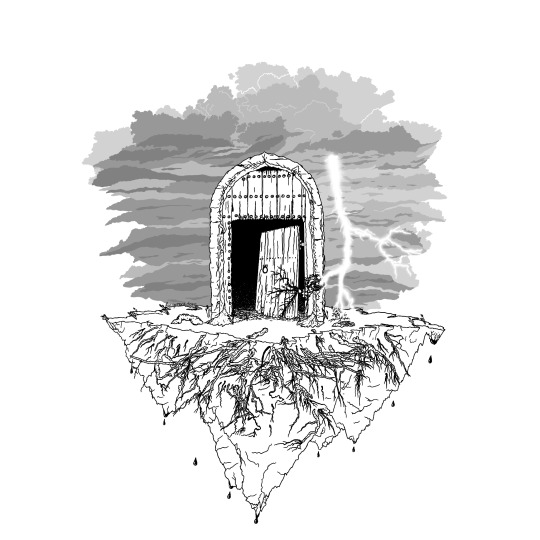
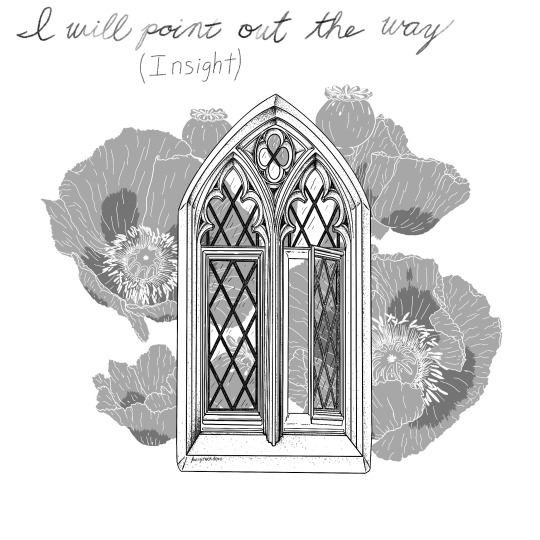


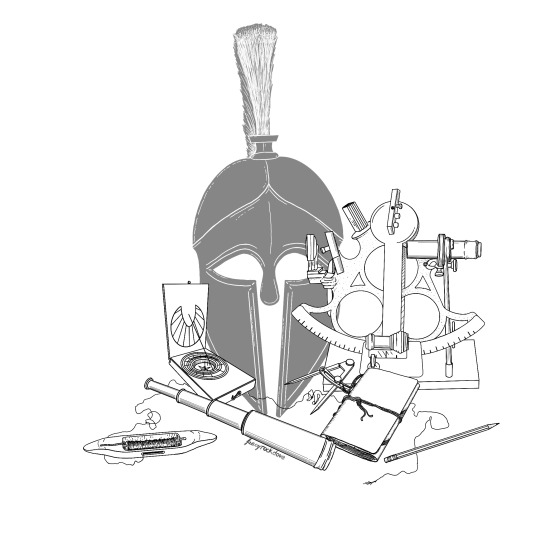
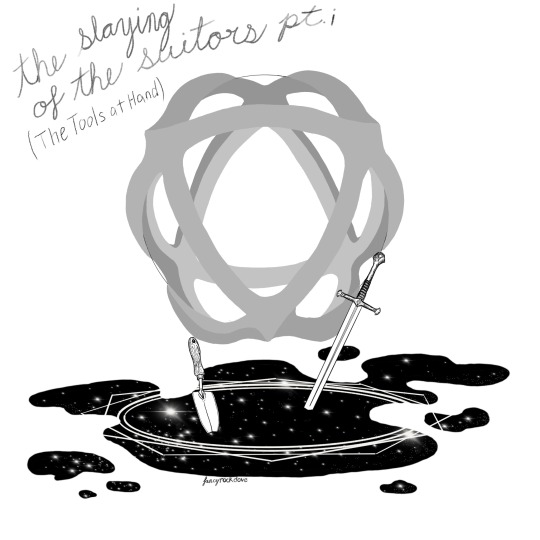

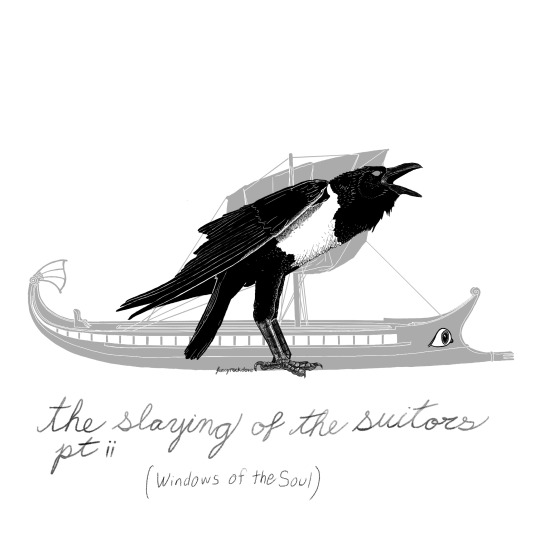
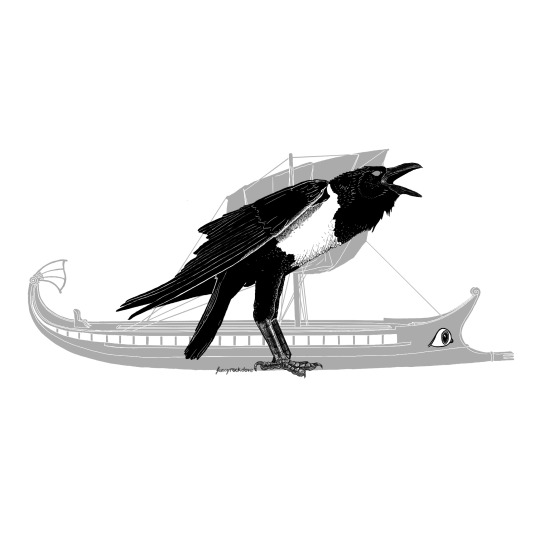
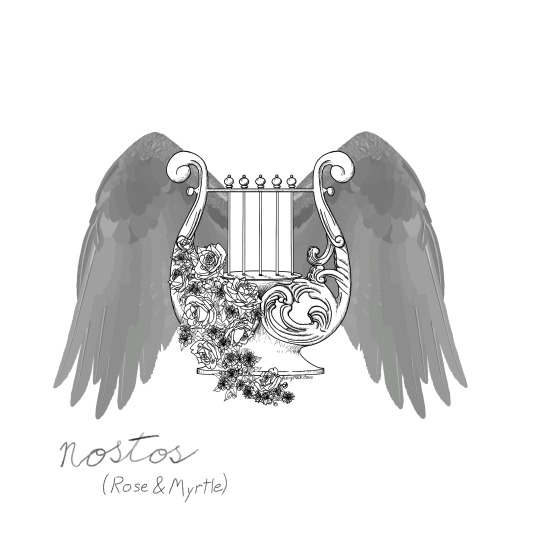
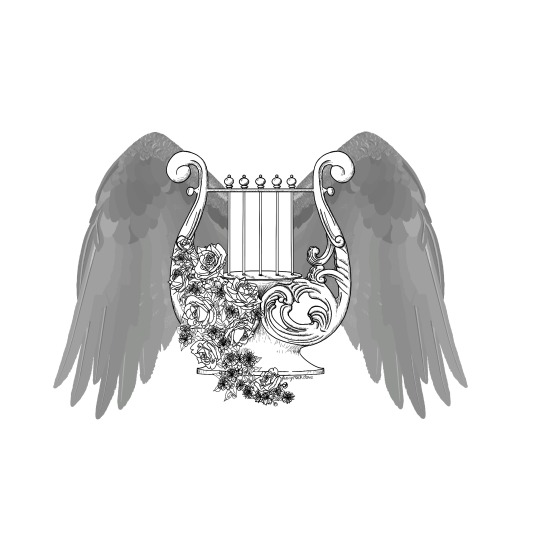
Ch 1: Baobabs are some of the oldest living flowering plants on the planet and can live up to two millennia. I have a lot of feelings about the sheer volume of life these trees can contain (both spatially and in time) and what that means for how we look at them.
Ch 2: If Abel were looking to avoid anachronism, he could still absolutely have left out books that were machine-printed with moveable type, but they'd probably have to have been in Chinese or Korean, from somewhere that had already widely adopted the technology by the 14th century.
Ch 3: Homer's works contain what is believed to be the first written mention of apples in Ancient Greece. Its writing is about as many centuries removed from the events of the Odyssey as the events of this chapter are from the first recorded mention of apples in England.
Ch 4: An ink quill is definitely more aesthetic, but graphite had actually been discovered in England and pencils invented in the decades prior to Shakespeare's first writings. It's entirely possible he could've been jotting down quick notes with a pencil like any stagehand today.
Ch 5: Though Corinthian style architecture is named for the Greek city of Corinth, with which it's associated, its inventor Callimachus is actually thought to be Athenian. The spiny, curling acanthus leaves used in its motifs are generally associated with long life, immortality, and rebirth. Go figure.
Ch 6: Symbolically, clovers are a sign that others are thinking of you. They're associated with good fortune, and apparently also male energy, and seen as a sign of protection. Excellent Fiddler's Green groundcover here.
Ch 7: Three-masted, fully-rigged ships became common in Europe by the 16th or 17th centuries during the Age of Sail because the extra space for sails became more necessary with the increase in open-ocean voyages. Making them the go-to type of vessel for both trade and exploration.
Ch 8: The simple but effective design of drop spindles is largely unchanged from their first documented use in the first century CE. there's evidence of their use for spinning (making a single, stronger thread from many disparate fibers) dating back at least to the advent of agriculture, some 10,000 years ago. Definitely what I picture Clotho using.
Ch 9: The fractal, branching structures of roots, lightning, and Lichtenberg figures are all self-similar: you can get much closer and they'll still appear very similar or identical to the way they were at a distance.
Ch 10: The throne room scenes of Sandman were shot in Guildford Cathedral. The Dreaming's Castle was intentionally designed to be a mashup of a whole ton of architectural styles, but the facade and throne room definitely feel gothic or neo-gothic. It's been a classic for centuries and the gothic-style window is definitely the kind I picture Hob's room having, at least on days the castle's feeling a bit fancy.
Ch 11: The item at the front left there is a weaving shuttle. According to Artemidorus, while dreaming of most kinds of looms indicates that you should expect rest, dreaming of a warp-weighted loom -- the kind which was common in bronze-age Greece and enables multiple people to work together on the weaving -- indicates an upcoming journey.
Ch 12: I feel like I've already talked about the symbolism of this one elsewhere, so for this one, instead of a fact, a comment (that I found fun): The binding circle in this only shows up in areas covered by the puddle of the Dreaming Sea, the means by which the nature of the "gilded ring" was elucidated. :)
Ch 13: Greek ships often had eyes on their bow, which among other things, was intended to imbue them with some will and ability to avoid obstacles. The Argo famously had eyes and also some innate awareness/intelligence, and could actually speak to the crew.
Ch 14: While Calliope, muse of epic poetry and eloquence (and the one invoked at the beginning of the Odyssey) is associated with a book, scroll, or tablet, Erato, muse of romantic poetry and love stories, is depicted in crowns of rose and myrtle. My title for this one was very nearly just (Invocation pt. ii). Also, I have a headcanon that Dream has only seen very bad performances of the Odysseyif ( he's seen any at all) since antiquity. Any show that literally begins by calling his ex is something he's not gonna stay for unless he's really sure she won't actually show up.
Whew! thanks to anyone who actually read to the end of my rambling here! Clearly this whole story has been really, really fun to just turn over in my mind. Cool stuff just keeps falling out of it! Since I would literally be two photos under Tumblr's limit on this post otherwise, how about a couple bonus alternate versions at the end here? Because why not?? I added some red accents to a couple of these for fun, and though it doesn't fit the for the chapter headings, I do think it looks cool!
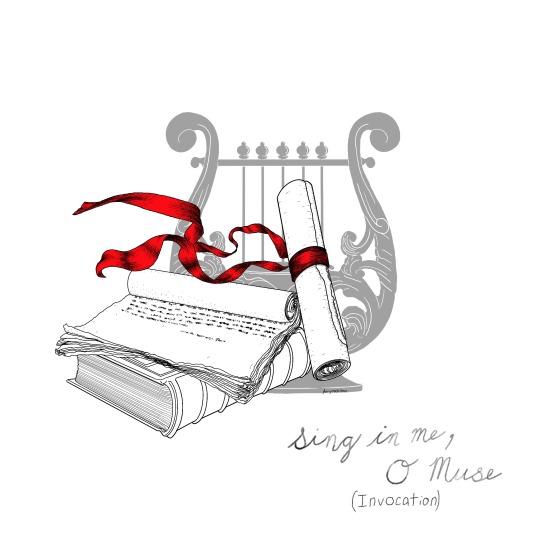
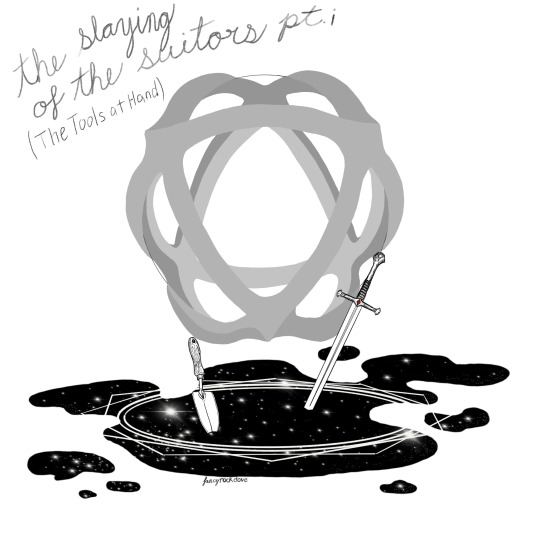
#Maybe Sprout Wings#fic rec#my art#the sandman#hob gadling#dream of the endless#long post#sorry?#how do I write art posts idk#dreamling
80 notes
·
View notes
Note
It's AAPI month! Any piece of media (book, show, movie, podcast...) to recommend us?
😄 Yes!
Films:
The Farewell, Directed by Lulu Wang - Chinese-born, U.S.-raised Billi (Awkwafina) reluctantly returns to Changchun to find that, although the whole family knows their beloved matriarch, Nai-Nai, has been given mere weeks to live, everyone has decided not to tell Nai Nai herself.
The characters are funny, heartwarming, and believable. The cinematography is moving. My older sister cried in the theatre and has re-watched it several times. ...my family is not Chinese, but my husband is half!
Wayfinders: A Pacific Odyssey, Directed by Gail K. Evenari - This award-winning PBS documentary sweeps viewers into a seafaring adventure with a community of Polynesians, as they build traditional sailing canoes, learn how to follow the stars across the open ocean, and embark upon a 2,000-mile voyage in the wake of their ancestors.
Papa Mau: The Wayfinder, Directed by Nāʻālehu Anthony - Papa Mau: The Wayfinder is a feature-length documentary that takes a retrospective look at the influence of Mau Piailug, a native from the tiny Micronesian atoll of Satawal, on reviving the art of non-instrument navigation in Polynesia. In Satawal, navigators are chosen at birth and begin training at an early age, and Mau was recognized as a master.
Moananuiākea: One Ocean, One People, One Canoe, Directed by Nāʻālehu Anthony - Moananuiākea is a feature-length documentary film telling the story of the Mālama Honua Worldwide Voyage of legendary canoe Hōkūleʻa. The three-year voyage connected countless individuals and communities from around the globe. Purchase it on Blu-Ray here.
I highly, highly recommend watching these documentaries and watching them in this order. They're online! Wayfinders is a 1-hour brief history of this significant part of the Hawaiian Cultural Renaissance in the 1970s, the preceding Western skepticism of Polynesian navigation, historical Polynesian cultural genocide, and the difficulties in reconnecting with the lost art of wayfinding. Mau Piailug is mentioned in the first documentary, but Papa Mau dives deeper into this amazing Micronesian man and how none of this could have happened without his patience and passion. Moananuiākea documents the results of unbelievable hard work to circumnavigate the globe using traditional techniques. It's about the next generation of navigators, environmental advocacy, and a celebration of indigenous cultures and pride around the world.
Books:
Crazy Rich Asians, China Rich Girlfriend, & Rich People Problems by Kevin Kwan - Chinese-American Rachel Chu travels with her boyfriend Nick Young to his home in Singapore for his best friend's wedding. Unknown to her, Nick not only belongs to one of the top ten wealthiest families in Asia but is possibly the sole heir to his family's great fortune.
I've watched the movie many times, and it's WONDERFULLY FUN, and yet the books are even better! The narrator is really funny, the side characters get a ton more interesting (particularly Colin Khoo and Kitty Pong). China Rich Girlfriend focuses more on Astrid, her husband Michael, and her ex-fiance Charlie.
The Latehomecomer: A Hmong Family Memoir by Kao Kalia Yang - Yang recounts her family's escape into Thailand during the Vietnam War, their immigration to America, and the challenges they faced adapting to a new place and language.
This was a required text before going to college, and it was definitely one of the best books I have ever read in my life. I met the author at a guest speaker college event, and she is one of the most beautiful people I have ever been blessed to hear and see. I couldn't believe her handle of language...it was like spoken poetry yet she was really just talking.
I have much more stuff I could recommend, but that's enough. Seriously, if you watched and enjoyed the Disney movie Moana, then you should watch the wayfinding documentaries.
17 notes
·
View notes
Text
Divinum Pacis’s Reference Guide- UPDATED 2021
Let’s face it, schooling is expensive, and you can’t cram everything you want to know into 4+ years. It takes a lifetime (and then some). So if you’re like me and want to learn more, here’s an organized list of some books I find particularly insightful and enjoyable. NEW ADDITIONS are listed first under their respective sections. If you have any recommendations, send them in!
African Religions 🌍
African Myths & Tales: Epic Tales by Dr. Kwadwo Osei-Nyame Jnr
The Ancient Egyptian Book of the Dead: Prayers, Incantations, and Other Texts from the Book of the Dead by E.A. Wallis Budge
Prayer in the Religious Traditions of Africa by Aylward Shorter (a bit dated but sentimental)
The Holy Piby: The Black Man’s Bible by Shepherd Robert Athlyi Rogers
The Altar of My Soul: The Living Traditions of Santeria by Marta Moreno Vega (autobiography of an Afro-Puerto Rican Santeria priestess)
African Religions: A Very Short Introduction by Jacob K. Olupona
Buddhism ☸
The Heart of the Buddha's Teaching: Transforming Suffering into Peace, Joy, and Liberation by Thich Nhat Hanh
The Dhammapada by Eknath Easwaran (collection of Buddha’s sayings)
Liquid Life: Abortion and Buddhism in Japan by William R. LaFleur
The Tibetan Book of the Dead by John Baldock (the texts explained and illustrated)
Teachings of the Buddha by Jack Kornfield (lovely selection of Buddhist verses and stories)
Understanding Buddhism by Perry Schmidt-Leukel (great introductory text)
Essential Tibetan Buddhism by Robert Thurman (collection of select chants, prayers, and rituals in Tibetan traditions)
Christianity ✝️
The Story of Christianity Volume 1: The Early Church to the Dawn of the Reformation by Justo L. Gonzales
The Story of Christianity Volume 2: The Reformation to Present Day by Justo L. Gonzales
By Heart: Conversations with Martin Luther's Small Catechism by R. Guy Erwin, etc.
Introducing the New Testament by Mark Allen Powell
Who’s Who in the Bible by Jean-Pierre Isbouts (really cool book, thick with history, both Biblical and otherwise)
Synopsis of the Four Gospels (RSV) by Kurt Aland (shows the four NT gospels side by side, verse by verse for easy textual comparison)
Behold Your Mother by Tim Staples (Catholic approach to the Virgin Mary)
Mother of God: A History of the Virgin Mary by Miri Rubin (anthropological and historical text)
Systematic Theology by Thomas P. Rausch
Orthodox Dogmatic Theology by Fr. Michael Romazansky (Eastern Orthodox Christianity)
Diary of Saint Maria Faustina Kowalska (very spiritual)
The Names of God by George W. Knight (goes through every name and reference to the Father, Son, and Holy Spirit in the Bible)
Icons and Saints of the Eastern Orthodox Church by Alfredo Tradigo (for those who like art history AND religion)
The Orthodox Veneration of the Mother of God by St. John Maximovitch (the Orthodox approach to the Virgin Mary)
East Asian Religions ☯️
Shinto: A History by Helen Hardacre
Tao Te Ching by Chad Hansen (a beautiful, illustrated translation)
The Analects by Confucius
Tao Te Ching by Stephen Mitchell
Shinto: The Kami Way by Sokyo Ono (introductory text)
Understanding Chinese Religions by Joachim Gentz (discusses the history and development of Taoism, Confucianism, and Buddhism in China)
Taoism: An Essential Guide by Eva Wong (pretty much everything you need to know on Taoism)
European (various)
Iliad & Odyssey by Homer, Samuel Butler, et al.
Tales of King Arthur & The Knights of the Round Table by Thomas Malory, Aubrey Beardsley, et al.
Early Irish Myths and Sagas by Jeffrey Gantz
The Prose Edda: Norse Mythology by Snorri Sturluson and Jesse L. Byock
Mythology by Edith Hamilton (covers Greek, Roman, & Norse mythology)
The Nature of the Gods by Cicero
Dictionary of Mythology by Bergen Evans
Gnosticism, Mysticism, & Esotericism
The Gnostic Gospels: Including the Gospel of Thomas, the Gospel of Mary Magdalene (Sacred Texts) by Alan Jacobs and Vrej Nersessian
The Kybalion by the Three Initiates (Hermeticism)
The Freemasons: The Ancient Brotherhood Revealed by Michael Johnstone
Alchemy & Mysticism by Alexander Roob (Art and symbolism in Hermeticism)
The Gnostics: Myth, Ritual, and Diversity in Early Christianity by David Brakke
What Is Gnosticism? Revised Edition by Karen L. King
The Essence of the Gnostics by Bernard Simon
The Essential Mystics: Selections from the World’s Great Wisdom Traditions by Andrew Harvey (covers Jewish, Christian, Muslim, Greek, Hindu, Buddhist, and Taoist traditions)
The Secret Teachings of All Ages by Manly P. Hall (huge book on esoteric and occult religions)
Freemasonry for Dummies by Christopher Hodapp
Hinduism 🕉
The Ramayana by R.K. Narayan
7 Secrets of Vishnu by Devdutt Pattanaik (all about Vishnu’s various avatars)
7 Secrets of the Goddess by Devdutt Pattanaik (all about Hindu goddesses, myths and symbolism)
Hinduism by Klaus K. Klostermaier (good introductory text)
Bhagavad Gita As It Is by Srila Prabhupada (trans. from a religious standpoint)
The Mahabharata, parts 1 & 2 by Ramesh Menon (super long but incredibly comprehensive)
The Upanishads by Juan Mascaro (an excellent introductory translation)
In Praise of the Goddess by Devadatta Kali (the Devi Mahatmya with English & Sanskrit texts/explanations of texts)
Beyond Birth and Death by Srila Prabhupada (on death & reincarnation)
The Science of Self-Realization by Srila Prabhupada
Krishna: The Beautiful Legend of God (Srimad Bhagavatam) by Edwin F. Bryant (totally gorgeous translation)
The Perfection of Yoga by Srila Prabhupada (about “actual” yoga)
Islam ☪️
The Handy Islam Answer Book by John Renard (a comprehensive guide to all your questions)
The Illustrated Rumi by Philip Dunn, Manuela Dunn Mascetti, & R.A. Nicholson (Sufi poetry)
Islam and the Muslim World by Mir Zohair Husain (general history of Islam)
The Quran: A Contemporary Understanding by Safi Kaskas (Quran with Biblical references in the footnotes for comparison)
Essential Sufism by Fadiman & Frager (select Sufi texts)
Psychological Foundation of the Quran, parts 1, 2, & 3 by Muhammad Shoaib Shahid
Hadith by Jonathan A.C. Brown (the history of Hadith and Islam)
The Story of the Quran, 2nd ed. by Ingrid Mattson (history and development of the Quran)
The Book of Hadith by Charles Le Gai Eaton (a small selection of Hadith)
The Holy Quran by Maulana Muhammad Ali (Arabic to English translation, the only translation I’ve read cover-to-cover)
Mary and Jesus in the Quran by Abdullah Yusuf’Ali
Blessed Names and Attributes of Allah by A.R. Kidwai (small, lovely book)
Jainism & Sikhi
Understanding Jainism by Lawrence A. Babb
The Jains (The Library of Religious Beliefs and Practices) by Paul Dundas
The Forest of Thieves and the Magic Garden: An Anthology of Medieval Jain Stories by Phyllis Granoff
A History of the Sikhs, Volume 1: 1469-1839 (Oxford India Collection) by Khushwant Singh
Sikhism: A Very Short Introduction by Eleanor Nesbitt
Judaism ✡
Hebrew-English Tanakh by the Jewish Publication Society
Essential Judaism by George Robinson (this is THE book if you’re looking to learn about Judaism)
The Talmud: A Selection by Norman Solomon
Judaism by Dan & Lavinia Cohn-Sherbok (introductory text)
The Jewish Study Bible, 2nd edition by the Jewish Publication Society (great explanations of passages)
The Hebrew Goddess by Raphael Patai
Native American
God is Red: A Native View of Religion, 30th Anniversary Edition by Vine Deloria Jr. , Leslie Silko, et al.
The Wind is My Mother by Bear Heart (Native American spirituality)
American Indian Myths and Legends by Erdoes & Ortiz
The Sacred Wisdom of the Native Americans by Larry J. Zimmerman
Paganism, Witchcraft & Wicca
Magic in the Roman World: Pagans, Jews and Christians (Religion in the First Christian Centuries) 1st Edition by Naomi Janowitz
The Greek Magical Papyri in Translation: Including the Demotic Spells: 2nd Edition by Hans Dieter Betz
Wicca for Beginners: Fundamentals of Philosophy & Practice by Thea Sabin
The Path of a Christian Witch by Adelina St. Clair (the author’s personal journey)
Aradia: Gospel of the Witches by C.G. Leland
The Anthropology of Religion, Magic, & Witchcraft, 3rd ed. by Rebecca L. Stein
Paganism: An Introduction to Earth-Centered Religions by Joyce & River Higginbotham
Christopaganism by Joyce & River Higginbotham
Whispers of Stone by Tess Dawson (on Modern Canaanite Paganism)
Social ☮
Tears We Cannot Stop (A Sermon to White America) by Eric Michael Dyson (concerning racism)
Comparative Religious Ethics by Christine E. Gudorf
Divided by Faith by Michael O. Emerson (on racism and Christianity in America)
Problems of Religious Diversity by Paul J. Griffiths
Not in God’s Name by Rabbi Jonathan Sacks (on religious terrorism)
The Sacred and the Profane by Mircea Eliade (difficult but worthwhile read)
World Religions 🗺
Understanding World Religions by Len Woods (approaches world religions from a Biblical perspective)
Living Religions, 9th ed. by Mary Pat Fisher (introductory textbook)
The Norton Anthology of World Religions: Hinduism, Buddhism & Daoism by Jack Miles, etc.
The Norton Anthology of World Religions: Judaism, Christianity, & Islam by Jack Miles, etc.
Zoroastrians: Their Religious Beliefs and Practices by Mary Boyce
The Baha’i Faith by Moojan Momen (introductory text)
Saints: The Chosen Few by Manuela Dunn-Mascetti (illustrated; covers saints from Christianity, Islam, Hinduism, and more)
The Great Transformation by Karen Armstrong (the evolutionary history of some of the world’s greatest religions)
Roman Catholics and Shi’i Muslims: Prayer, Passion, and Politics by James A. Bill (a comparison of the similarities between Catholicism & Shi’a Islam)
God: A Human History by Reza Aslan (discusses the evolution of religion, specifically Abrahamic and ancient Middle Eastern traditions)
A History of God by Karen Armstrong (similar to Aslan’s book but much more extensive)
The Perennial Dictionary of World Religions by Keith Crim

#religion#world religions#reference#judaism#christianity#islam#hinduism#buddhism#jainism#sikhism#paganism#witchcraft#wicca#library#divinum-pacis
230 notes
·
View notes